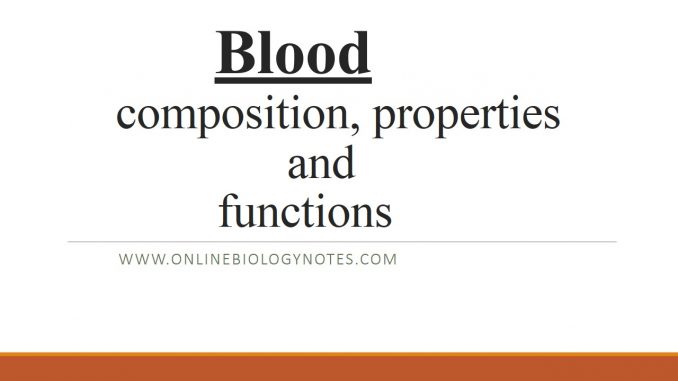
Blood: composition, properties and functions
- Blood is a liquid connective tissue that contains cellular elements (blood cells) and fluid matrix (plasma).
- Blood helps in the transportation of different substances throughout the body.
- Study of blood and its disease is known as Hematology
Composition of Blood:
- Cellular substances (Blood cells) : 45% (44% RBC & 1% buffy coat containing platelets & WBC)
- Plasma: 55% (Of total: 91% liquid & Solid 9%).
Blood cells:
- Erythrocytes or Red blood cells (RBC), Leucocytes or White blood cells (WBC) and Platelets or Thrombocytes
1. Erythrocytes or Red blood cells (RBC)
- Biconcave, anucleate disc shaped of 7µm in size.
- The normal count= 4.5-5.5 lakhs/mm3. It is measured by haemocytometer
- The life span of RBC is 120 days.
- RBC contain blood pigment called Haemoglobin.
- Total haemoglobin in our body is about 900 gm. It occupies about 1/3 of RBC.
- RBC is produced in bone marrow by the process called Erythropoiesis
- The immature nucleated RBC is called Reticulocyte.
2. Leucocytes or White blood cells (WBC)
- Large size, oval in shape, cell contain nuclei & some of them have granules.
- Normal count-4000-11,000 per mm3.
- 2 types-Granulocytes and Agranulocytes. These differ in size, shape, life span & functions.
- Granulocytes includes- Neutrophils, Basophils & Eosinophils
- Agranulocytes include –lymphocytes and monocytes
i. Neutrophils
- It is most abundant WBC (40-70%) of total WBCs.
- It is phagocytic in nature.
- It is the first line of defense against bacteria.
- Phagocytosis by Neutrophil is facilitates by Opsonization by antibody
- The life span is 6 hrs.
ii. Eosinophils
- 1-4% of total WBCs
- It destroys parasites & neutralize histamine released during allergic reaction. So, it is increased in parasitic infestation & in allergic reactions.
- It is stained by acidic dye. Eg, eosin dye.
iii. Basophils
- About 1% of total WBCs.
- It contain basophilic granules.
- It resembles mast cells in connective tissue.
- It contains histamine, heparin & serotonin.
- It is stained by basic dye
iv. Lymphocytes
- 20-40% of total WBCs. It is the smallest WBC.
- There are 2 types of lymphocytes.
- B-lymphocytes is concerned with humoral immunity.
- T lymphocytes is concerned with cell mediated immunity.
v. Monocytes
- 2-8 % of total WBCs, Have horse-shoe kidney shaped nucleus. It is the largest WBC.
- It differentiates into Macrophages as it enters the tissues which express MHC (Major histocompatibility complex).
- Macrophages in different parts of the body are given different names as follows
- Kupffers cells= liver
- Osteoclast cells= bone
- Microglial cells= brain and spinal cord
- Histiocytes =Connective tissue
- Dust cells (alveolar macrophage)= Lungs
- Hassal’s corpuscles= Thymus
3. Platelets or Thrombocytes
- They are small non granulocytes disc
- They are derived from pinching off the cytoplasm of the Giant cell megakaryotes in the red bone marrow.
- Normal count is 1.5-4.5 lakh/mm3.
- Life span 7-10 days.
- Platelet is to help in coagulation. Thromboplastin is secreted by platelets during blood clotting.
Plasma
- Plasma = (Blood- Blood cells)
- It is the liquid part of blood and is composed of 90-92 % water, 7-8 % plasma protein and 1-2% other substances (glucose, amino acids, electrolytes, ammonia, enzymes, hormones, vitamins, etc).
- Translucent, yellowish, little viscous when centrifuged.
- Normal range: 60-80 gm/dl of blood.
- Plasma proteins: Helps in maintaining osmotic pressure, coagulation of blood, viscosity, blood pressure, defensive action, transport of gases.
- The solvent property of water helps in transport of nutrients as well as metabolic wastes from one part of body to another part
- Liver produces about 30gm of plasma protein each day.
- They are of three types:
- Albumin: (58-60%) most abundant, main function is to maintain is to maintain plasma osmotic pressure (Oncotic pressure).
- Globulin: (36-38%) – It is important for immunoglobulin. The most important globulin is gamma globulin.
- Fibrinogen: (3-4%) – It helps in blood clotting.
- Electrolytes- Na, K, Cl, Ca, HCO3
- Nutrients- Glucose, amino acids, fatty acids, Vitamins & minerals.
- Gases: Oxygen, Carbon dioxide, Nitrogen.
- Waste products: Urea, Uric acid, Creatinine.
Properties of Blood:
- Amount: : 7-9% of total body weight; 79ml/kg
- Blood volume: 5-6 liters
- Viscosity: (3.5-5.5) times more than water.
- Specific Gravity:045-1.065
- PH:3-7.4 (slightly alkaline)
- Venous blood has low pH than the arterial blood as venous blood has more CO
- Temperature- 380C (100.4F)
- Osmotic pressure– 25 mm Hg.
- Color: red, due to haemoglobin
Functions of Blood
i. Transportation:
- transport of O2 from lungs to body tissue and CO2 from tissue to lungs
- transport of wastes of cellular metabolism from body tissue to kidney, liver or sweat gland and eventually removal out of body
- Transport of hormones, enzymes, other chemicals throughout the body.
- Nutrients absorbed in the digestive tract, such as glucose, amino acids, vitamins, minerals etc and are circulated to all body tissues.
- Waste products of the tissues, such as urea and creatinine, circulate through the kidneys and are excreted in urine.
ii. Regulation (Homeostasis):
- regulate body temperature
- distribution of heat throughout the body
iii. Balance
- Maintaining electrolyte balance
- Maintain acid base balance
iv. Protection:
- protect body from harmful microorganisms, by WBCs, protein and antibody
- develop immune response (plasma protein).
